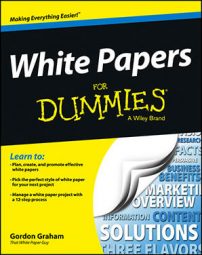One white paper mash-up that can be quite successful is a backgrounder with a numbered list. The lightness of the numbered list can make a backgrounder more appealing to a wider audience at the middle of the sales funnel, not just the bottom.
When to use this white paper combination
Try this combo when you want to lighten up and extend the reach of a backgrounder with the appeal of a numbered list or to spread FUD (fear, uncertainty, and doubt) on all the competing offerings — and when you can’t spare the time, money, or attention to do two separate white papers.
Check out this example, called “EFM Evaluation Guide: 20 Must-Have Capabilities for a True Enterprise Feedback Management System” that listed a set of desirable features for this particular genre of software. It included a checklist to confirm that the white paper sponsor had the most capable offering on the market, casting doubt on every other product in that category.
What to include and what to leave out of your white paper
In a backgrounder–numbered list mash-up, you probably want to include a cover and perhaps a contents and copyright page as front matter. These items signify that the paper is somewhat more ambitious than a pure numbered list, where the front matter is more limited.
In the main body, make sure to include a brief introduction and then provide a lot of specific details about the features and benefits of your offering, all structured as a numbered list.
For example, this type of mash-up can be organized as a set of must-have features every buyer should check for, a list of capabilities of the most advanced offerings in your niche, a number of items not to overlook, or a set of questions to ask every vendor, along with your answers for your offering.
For back matter, include some brief conclusions, your call to action, and some brief boilerplate about the company.
Leave out any sweeping analysis of industry-wide problems and the failings of competing products, except for brief mentions or short sidebars. In this type of mash-up, you likely won’t need any buyer’s guide, footnotes, or endnotes, which are problem/solution elements that can overwhelm this type of white paper with too much complexity.

